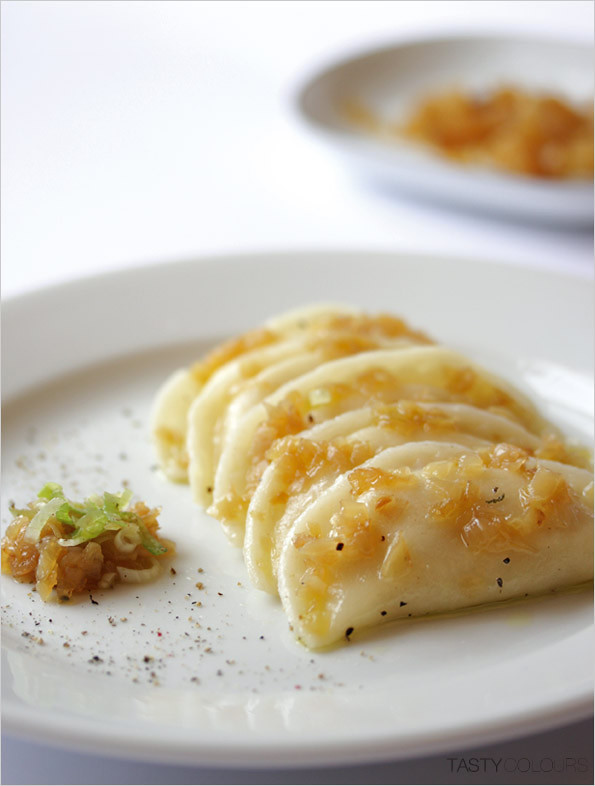Serves 4
Ingredients
440 g pierogi dough (click HERE for the basic pierogi dough)
600 g potatoes
200 g dry curd cheese
3 onions, peeled, washed and finely chopped
5 tablespoons clarified butter
Salt and pepper to taste
1 bunch fresh chives, washed and finely chopped
Preparation
In a large saucepan, boil water and cook potatoes, with skin on.
Strain and let cool down a bit; peel them when still warm and mash them using a potato masher.
Let potatoes cool down.
Using the potato masher, mash the cheese
Working with hands, carefully mix potatoes and cheese.
Put aside.
In a hot frying pan, melt butter, add onions and cook on a low flame for 20 minutes.
Do not let onions burn.
Combine 1/3 of onions into the potato / cheese mixture.
Reserve remaining onions.
Season with salt and pepper and mix again thorough fully.
The taste should be quite seasoned.
Prepare and cook pierogi as described HERE.
Serve immediately after cooking with the remaining onions sprinkled with some chopped chives, grilled bacon or pork back fat.
The filling of these pierogi should be piquant. Part of their peppery taste is lost while cooking, and if you do not season the stuffing with heart, the pierogi will be too blend in taste.
The best cheese for the pierogi is the Polish hard, curd cheese. In France, as in other countries, you usually can buy it in stores selling Polish and Russian food. However, curd cheese is quite easy to make at home. I will write a recipe for curd cheese in the nearest future.
The stuffing for the pierogi must be thick. The best proportions are 3 parts of potatoes and 1 part of cheese. Otherwise, the stuffing will become too liquid.
Pierogi also taste great on the second day, grilled on a frying pan with a bit of butter.
The name of this dish, in Polish, is misleading and its history is a bit complicated. A direct translation of the term “ruskie” suggests that the dish has its origins in Russia. Make no mistake! It relates to the ancient name of Ukraine, which was “Kievian Ruś”. In ancient cookbooks published before the First World War, those pierogi are called “pierogi with potatoes and cheese”. Before the Second World War, the same dish in Ukraine was called “Polish pierogi”.
It is most likely that “Pierogi Ruskie” were created by the Poles living, at that time, in the Ukrainian territories. Those territories belonged to Poland before the Second World War and the dish was very popular amongst the Polish minority leaving there.
These pierogi got their new name – “ruskie” - after the Second World War only. The frontiers of Poland had been changed by history. Thousands of Polish people were forced to leave their homes in West Ukraine and move to Poland, more particularly to western territories.









5 comments:
These are called "Varenikes" for many of us...
Yes, in Russia :)I do not know about Ukraine.
In Poland, we called them "pierogi".
They are called varenuku in Ukraine too, not pirogies, pirogies is indeed a polish word
in Poland, we use a term "pierogi"; this kind of preparation is known both in Ukraine and in Russia, as well as in Poland; anyway, it is a kind of Eastern European preparation which should be promoted abroad.
I am 100 percent Polish, born there and raised in Canada. When I was little one of my friends here had a Ukrainian baba and when she spoke about baba's perogies she called them "peroheh". Has anyone called perogies using this pronunciation ? This preceding recipe sounds great, it's different than mine but I'm going to try it.
Post a Comment